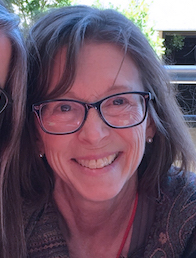 myCSUSM
myCSUSMSeptember 2019
Dr. Martha Stoddard Holmes

- What is your favorite book to read for fun?
In the nineteenth century, anything by Austen, the Brontes, Wilkie Collins, or (most of) Dickens and George Eliot. I’m teaching Jane Eyre right now and it is a delightful read the 10th or so time around. I could read the Palliser (“Parliamentary”) series by Anthony Trollope, which follows British politics and gender politics among an interconnected group of Victorians, any day of the week. In the twentieth century, anything by Virginia Woolf or anything by Laurie Colwin, especially Happy All the Time, which makes me happy. I also love to reread children’s books, which is sort of how our Children’s Lit into Film course came about! - What's your favorite book to teach?
Wilkie Collins’s The Woman in White because I get the fun of introducing students to a book that has made generations of readers stay up all night reading to find out what happened next! - Do you have a favorite film?
I’m always watching movies, so too many choices…In terms of comfort film, I could watch a whole range of things from The Devil Wears Prada to Local Hero to Bringing Up Baby any old day of the week—or any film translation of an Austen or Bronte or E.M. Forster or Edith Wharton or Henry James novel—I’m a huge Merchant/Ivory fan. - How do you spend your free time?
Write; read; dig in the garden; play the dulcimer; do yoga; take long meandering walks; make things (food, art, household fixes); build meals I like to eat and eat them watching movies, ideally with my son and husband; visit my sisters in New Hampshire and my brother on the Central Coast; read; watch Cooper’s hawks, acorn woodpeckers, hummingbirds, and my Maine Coon cat; daydream, meditate, nap. - What is your biggest literary inspiration?
Anyone who gets past the many barriers and embraces a way of living that is always creating rather than consuming is an inspiration to me, but I am particularly inspired by women who find ways to write and create in the midst of the arduous and important work of daily life--and the pressures of gendered expectations of caring and care. Jane Austen and the Brontes were examples of this, for certain, but their counterparts who were parents (sometimes single parents) had an even more challenging task and kept their families fed by doing it in a time in which women’s writing was widely consumed, but women writers were not necessarily treated with respect.
I believe creating things should be as continual and embodied in life as breathing, but that takes a leap of faith, to say nothing of material, emotional, and temporal support. - What's your cure for writer's block?
I actually don’t get writer’s blocks; I can always write something. I do get blocked over certain projects, usually if they mean too much to me or I’m afraid I will fail at them. I feel physically frozen regarding these projects and am very very uncomfortable until I start the work and break the block. Here are some of my methods: 1) Draw my way into writing. Just sit with a pen and draw, which usually leads me to make a weird visual outline of some kind, and then the work is in progress—it’s going. 2) Go for a bike ride or do yoga or swim or bake or clean house (something physically absorbing), but with the project I’m avoiding held gently in my mind. I sit to down to write immediately after. 3) Break the task into small chunks, with a list of them ordered by time and emotional energy needed and with lovely rewards (cookies, tea, playing words with friends, 15 minutes of weeding) assigned to completing each one—then just pick one and begin. 4) I just move to the number two project on my list, which is usually less dread-filled, so at least I get something done (productive procrastination). 5) Set a timer for 25 minutes, then use my free Insight Timer meditation app to do a stress-release or self-compassion or creativity meditation, which usually ends in a refreshing short nap that generates optimism about writing. I love the “Power Nap” meditation--the teacher has a great Scottish accent and it always makes me smile when he says not to listen to the recording while I’m driving or operating machinery. - What are you working on outside of class?
I’ve spent the last few years coediting a book on Disability in the Long Nineteenth Century (1776-1918), part of a six-volume reference on the Cultural History of Disability that will appear in print late this year! I also have essays in a 2019 collection on Frankenstein, Disability, and Chemistry and a 2020 Routledge Companion to Victorian Literature. I’m currently working on an essay on teaching Jane Austen through film, based on one of the courses I created here at CSUSM. Closer to my heart, though, is a creative project that has stretched on for several years: I’m trying to transform my creative nonfiction about my cancer experiences into a graphic narrative that might help others thrive in the process of diagnosis and treatment. So, if you see me doodling during a meeting, I’m just tuning the instrument.
- Fun Fact:
I believe in the medicinal value of dark chocolate!






